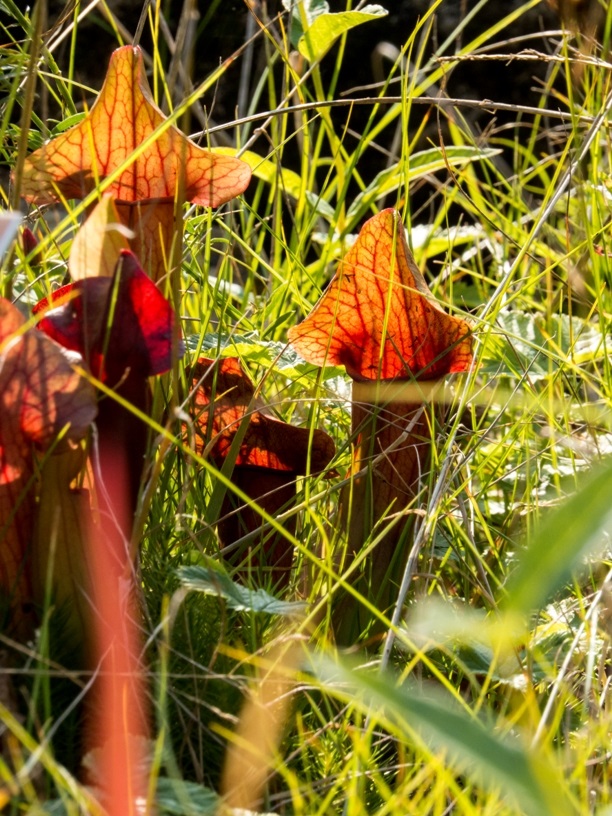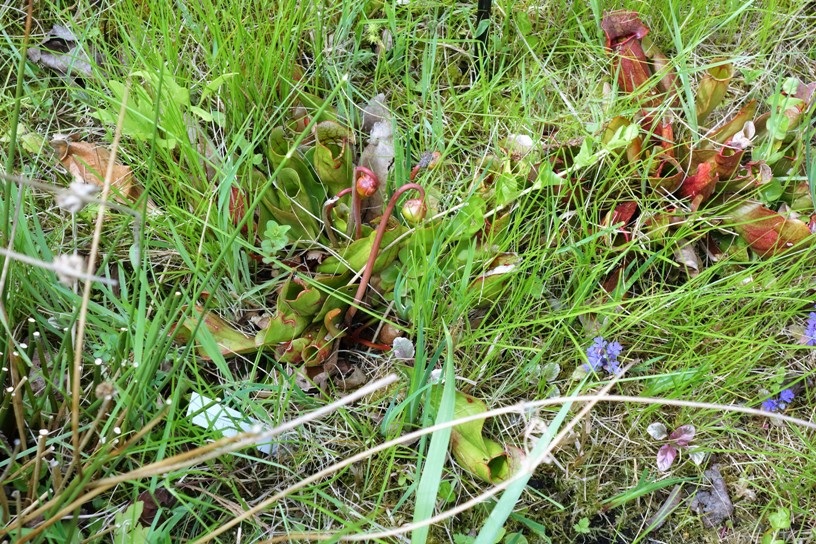purple pitcherplant
Sarracenia purpurea var. purpurea
Pitcherplant family (Sarraceniaceae)
Eats wasps too
The small genus Sarracenia has specials ‘organs’ (modified leaves in a shape of a pitcher) by which it catches insects (including large ones such as wasps) and digests them. In everyday language these are being called ‘carnivorous’ plants. All pitcherplants occur in North America but only two species (Sarracenia purpurea and Sarracaenia flava) are frost hardy and are often planted in gardens in the Netherlands.
Carnivorous plants occur on nutrient-poor soils. The insects that fall into the pitchers, drown. The minerals from the digested insects are absorbed by the plant and so provide it with nutrients. The purple pitcherplant has upright pitchers that contain attractants around the edge. The large, nodding flowers are pollinated mainly by bees.
Read more.... »Themes
In de traditionele geneeskunde in Noord Amerika werd deze plant gebruikt als pijnstiller, tegen infectieziekten zoals tuberculose, en om de symptomen van suikerziekte te behandelen. Wortels en bladeren (vangbekers) worden soms nog steeds gebruikt om maag-, darm-, lever- en nierklachten te behandelen, en ook om hoest en koorts te verhelpen en om aan te sterken na de geboorte van een kind. De bovengrondse delen van de plant vertoonden in testen daadwerkelijk bescherming tegen celschade veroorzaakt door hoge glucoseconcentraties, met als werkzame stoffen hyperoside en morroniside, evenals verlaging van de bloedsuikerwaarde, met diverse geïdentificeerde werkzame stoffen. Ook bleken er triterpenen aanwezig die activiteit vertoonden tegen mycobacteriën, hetgeen de werking tegen infectieziekten bevestigt.
Remarkable, perennia, carnivorous plant. The leaves are modified to form the pitcher that lures insects into them before falling on the slippery edge into the pitcher and drowning in the rainwater collected in the bottom. The pitcher produces digestive enzymes for at least a year. There is a complicated cooperative interaction between the enzymes and two types of mosquito larvae, and - in the second year - bacteria in the pitcher in order to enable digestion of the submerged prey.
This species is the floral emblem of the Canadian province of Newfoundland and Labrador.
This is the most common, and most widespread, pitcher plant, which can grow in cold, temperate regions.
Details
| Description: | Carnivorous plant, up to 20 cm. |
|---|---|
| Distributions: | Eastern north america |
| Habitat: | In wet, acidic grassland, marshes and bogs, at altitudes below 1200 m. |
| Year cycle: | Perennial (trees and shrubs included) |
| Hardiness: | 14 - 23 f (hardy - average winter) |
| Flowering period: | Mei - juni |
| Flower color: | Green, purple, red, white |
| Notes on flowers: | The flower is purplish to red with a 'hood' bearing a beautiful tree-like venation pattern. |
Sources
https://pfaf.org/user/Plant.aspx?LatinName=Sarracenia+purpurea,http://ucjeps.berkeley.edu/eflora/eflora_display.php?tid=43271,
https://en.wikipedia.org/wiki/Sarracenia_purpurea,
http://www.sarracenia.com/faq/faq5538.html,
Morrison S.A. et al. - 2016. Antimycobacterial triterpenes from the Canadian medicinal plant Sarracenia purpurea. Journal of Ethnopharmacology 188: 200-203. https://www.ncbi.nlm.nih.gov/pubmed/27174081,
Muhammad A. et al. - 2012. Antidiabetic compounds from Sarracenia purpurea used tradit


